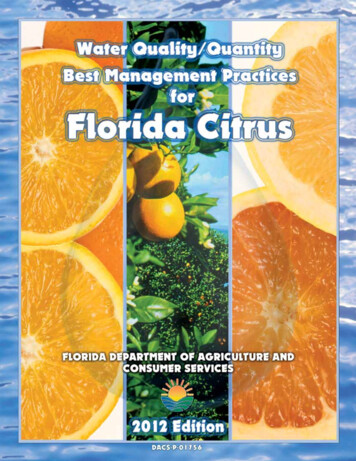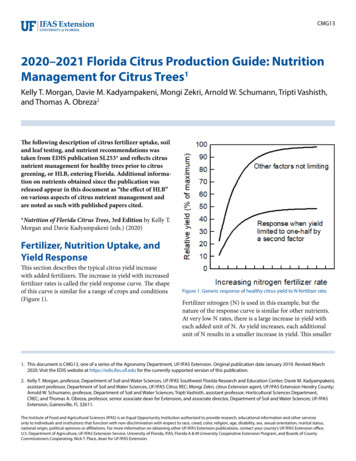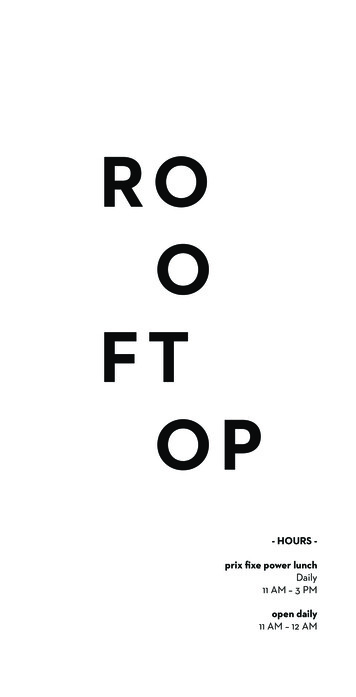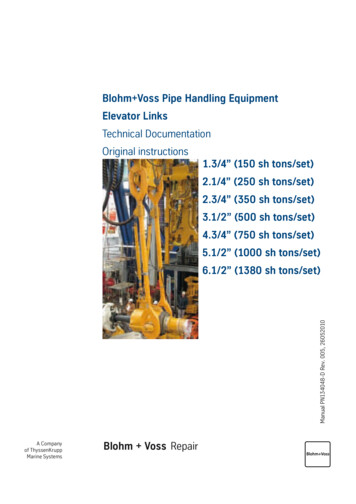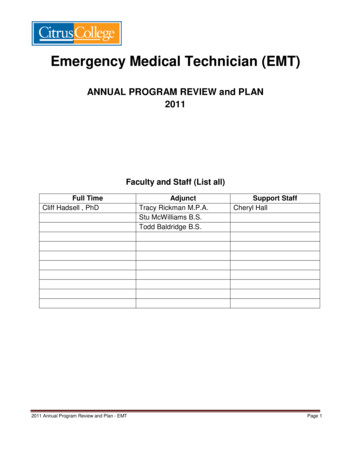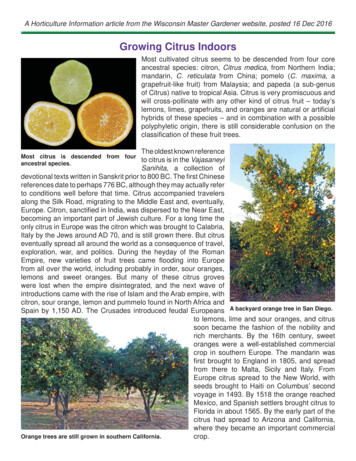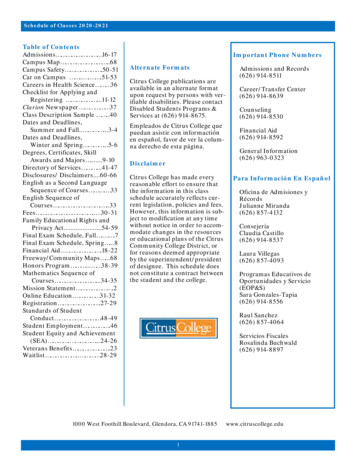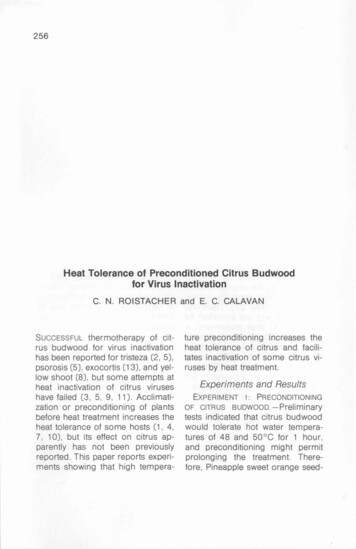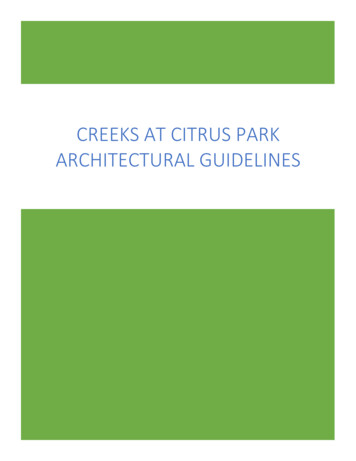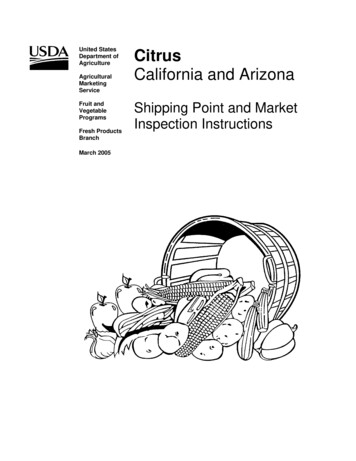
Transcription
United StatesDepartment ofAgricultureAgriculturalMarketingServiceFruit andVegetableProgramsFresh ProductsBranchMarch 2005CitrusCalifornia and ArizonaShipping Point and MarketInspection Instructions
Shipping Point and MarketInspection Instructions forCalifornia and Arizona CitrusThese inspection instructions are specifically developed by the Fresh ProductsBranch to assist officially licensed inspectors in the interpretation and application of theU.S. Standards for Grades of California and Arizona Oranges and California andArizona Grapefruit, Sections 51.1085 and 51.925 respectively.These instructions do not establish any substantial rule not legally authorized bythe official grade standards. This publication supersedes any previously issuedinspection instructions.Refer to the General Inspection Instructions for additional information pertainingto date, inspection point, carrier, condition of carrier, lading, etc. that is not covered inthis handbook. Reference to “General Inspection Instructions” in all Fresh ProductsBranch publications refers to any one or all of the following - General Shipping PointInspection Instructions, General Market Inspection Instructions, or Fresh Fruit andVegetable Certificate Writing Handbooks.Any portion of these instructions beginning with the section number §51.--- andfollowed by bold print are sections or portions of sections copied directly from U.S.standards. The U.S. Standards for Grades of Oranges (California and Arizona) andGrapefruit (California and Arizona) are printed in the appendix of this handbook. AllU.S. standards are available on the Internet under the USDA homepage.March 2005This replaces Market Inspection Instructions dated August 2001.This publication may be duplicated without authorization from USDA.
Revised, February 2007, HU-152-3(a),Table of Contents, Page i, Citrus, California and Arizona, ShippingPoint and Market Inspection Instructions, March 2005Factors noted with (Q) are considered QUALITY only. Factors noted with (C) areconsidered CONDITION at market. Factors noted with (Q or C) may be QUALITY orCONDITION depending on the circumstances. Factors not designated do not pertain toeither category.TABLE OF CONTENTSCITRUS ILLUSTRATION . 1SECTION ONE . 2GENERAL . 2REPRESENTATIVE SAMPLING . 2Sample Size . 2Sampling Bulk Loads . 3Number of Samples . 4Sampling For Internal Defects . 4TOLERANCES. 8APPLICATION OF TOLERANCES . 10STANDARDS FOR EXPORT. 11NOTESHEET AND CERTIFICATE . 12Product . 12Number/Type of Containers . 12Brands/Markings. 13Origin . 13TEMPERATURE OF PRODUCT . 13CONDITION OF PACK . 13STANDARD PACK . 14STANDARD SIZING AND FILL (ORANGES ONLY). 15SIZE . 15SECTION TWO - ORANGES . 17QUALITY AND CONDITION . 17Alternaria (Q or C) . 17Broken Skins (Q or C) . 17Bruises (C) . 18Color (Q). 18Creasing (Q) . 19Dirt and Other Foreign Matter (Q or C) . 19**** Firmness/Puffy (C). 20 ****Flesh Color and Seed Count . 20Freezing Injury (Q or C) . 21Granulation (Tree Dryness) (Q) . 21Maturity (Q) . 22Oil Spots or Similar Injuries (Q) . 23Scale (Q) . 23Scars (Q) . 24Skin Breakdown (C). 25i
Revised, February 2007, HU-152-3(b),Table of Contents, Page ii, Citrus, California and Arizona, ShippingPoint and Market Inspection Instructions, March 2005****Shape (Q) . 25Similar Varietal Characteristics (Q). 26Sooty Mold (Q) . 26Split, Rough, Wide or Protruding Navel (Q) . 27Stem Buttons and Attached Stems and/or Leaves . 27Stem End Aging (C). 27Sunburn (Q) . 28Texture (Q) . 29Decay (C) . 29SECTION THREE - GRAPEFRUIT . 31 ****QUALITY AND CONDITION . 31Alternaria (Q or C) . 31Blossom End Clearing (C) . 31Broken Skins (Q or C) . 32Unhealed Skin Breaks . 32Healed Skin Breaks . 32Bruises (C) . 32Cluster Rings (Q) . 33Color (Q). 34Dirt and Other Foreign Matter (Q or C) . 34Firmness (C) . 35Flesh Color and Seed Count . 35Freezing Injury (Q or C) . 36Granulation (Tree Dryness) (Q) . 37Maturity (Q) . 37Oil Spots or Similar Injuries (Q) . 38Scale (Q) . 39Scars (Q) . 39Shape (Q) . 40Similar Varietal Characteristics (Q). 41Skin Breakdown (C). 41Sooty Mold (Q) . 42Sprouted Seeds (C) . 42Stem Buttons and Attached Stems and/or Leaves . 43Sunburn (Q) . 43Texture (Q) . 44Decay (C) . 46APPENDIX I - U.S. GRADE STANDARDS . 47United States Standards for Grades of Oranges (California and Arizona). 47United States Standards for Grades of Grapefruit (California and Arizona) . 53APPENDIX II . 59Directive on Certifying Various Varieties of Citrus . 59Comparison of Areas of Circles Having Different Diameters . 62APPENDIX III . 63Example 1 - Inspection Notesheet . 63Example 1 - Inspection Scoresheet . 64Example 1 - Inspection Certificate . 65ii
Example 2 - Inspection Notesheet . 66Example 2 - Inspection Scoresheet . 67Example 2 - Inspection Certificate . 68iii
CITRUS ILLUSTRATION1
SECTION ONEGENERALThese inspection instructions apply to oranges and grapefruit grown in Californiaand Arizona.The following grade standards shall be used for import certification at ports ofentry:Oranges - U.S. Standards for Grades of Oranges (Texas and States other thanFlorida, California and Arizona) and the Texas maturity requirements apply, except fornavel oranges in which case the U.S. Standards for Grades of Oranges (California andArizona) shall apply with the Texas maturity requirements.Grapefruit - U.S. Standards for Grades of Florida Grapefruit and the Floridamaturity requirements shall apply.For inspections requested on imported fruit other than at port of entry, or whenimport requirements are not in effect, the grade standard the fruit most closelyresembles (texture, thickness of skin, discoloration and scarring) shall be applied.REPRESENTATIVE SAMPLINGThe importance of obtaining representative samples cannot be overemphasized. Accurate certification is possible only if the samples examined are trulyrepresentative of the entire lot or accessible portion. All portions of a lot or load shallreceive the same attention in sampling regardless of the difficulty involved in reachingthe more inaccessible layers or parts of a load.Sample SizeThe sample size for grade and size determination on all California - Arizonacitrus shall be a minimum of 25 fruit for each sample, regardless of container size.SHIPPING POINTIn-line Certification - Each sample shall consist of at least 25 fruit. If containershave less than 25 fruit, a composite sample of 25 fruit shall be examined. If sampletolerances are exceeded, examine 50 fruit when containers contain 50 or more fruit; ifcontainers contain more than 25 fruit, but less than 50 fruit, examine the entirecontents. The lot average must never exceed the lot tolerance.2
The first sample examined must meet all lot tolerances. If three consecutivesamples in a lot exceed a lot tolerance, a corrective action must be taken on the packedcontainers that are represented by the third sample.Stationary Lots - Sampling for all lots shall consist of at least 25 fruit. Ifcontainers have less than 25 fruit, a composite sample of 25 fruit or more shall beexamined. A minimum of 3 samples must be examined to certify a lot.If a lot tolerance is exceeded, double the sample size for containers containing50 fruit or more, except for composite samples. If a sample tolerance is exceeded,examine the entire contents of the container, except for bulk lots or bulk bins. Samplesize for bulk lots or bulk bins shall be limited to a maximum of 100 fruit.MARKETFor packages containing 25 fruit or more, a minimum of 25 fruit shall beexamined. When any sample tolerance is exceeded, the entire contents of at least onepackage which exceeded the sample tolerance must be examined. If impractical to runthe entire contents (i.e., extremely large numbers of fruit and bulk lots), examine aminimum of 100 fruit.For packages containing less than 25 fruit, a sufficient number of adjoiningpackages must be opened to obtain a minimum of 25 fruit. The entire contents shall beused for the sample when opening an adjoining package. For example: orangespacked in 5 lb. consumer bags (10 fruit per bag) - open 3 bags (30 fruit sample); 18count cartons of grapefruit - open 2 cartons (36 fruit sample). If a sample tolerance isexceeded using this method, do not double the sample size. The lot is out of gradebecause of the sample tolerance being exceeded.Sampling Bulk LoadsBulk loads (volume-filled trailers, pallet boxes, bulk bins, etc.) may contain up to60,000 pounds of fruit. The method of reporting defective fruit in bulk shipments isidentical to fruit packed in containers.When determining the minimum number of samples drawn from a bulk shipment,divide the loads approximate net weight by the appropriate “packed net weight” of thefruit (oranges, grapefruit and lemons – 40 pounds). This calculation provides a 4/5bushel equivalent. Use the calculated carton equivalent as a guide when determiningthe number of samples to be examined. EXAMPLE: Net weight of an orange load isapproximately 57,000 pounds; 57,000 40 (packed net weight) 1425 cartons.Examine a minimum of 25 contiguous fruit per sample. When a sampletolerance is exceeded, the sample size must be at least doubled. Report range andaverages in the appropriate sections on the certificate.3
When determining size, measure the largest and smallest fruit in each sampleand record the range on the notesheet. On the certificate, report the range and, ifneeded, include a “mostly” statement.Number of SamplesDue to potential variations in size, quality and condition, a specific number ofsamples per load or lot cannot be provided. It is the inspector’s responsibility toexamine a sufficient number of samples to ensure that a complete and accuratedepiction of the load or lot is obtained. The following information should be used forsampling guidelines:SHIPPING POINTIn-line Certification -- A minimum of one sample for every 200 containerspacked with at least 3 samples per lot, or 1/2 of 1% of the total containers packed,whichever is greater, is the recommended sampling rate.Stationary Lots -- A minimum of 1 percent of the packages within a load or lotis recommended with a minimum of three samples examined on any lot.MARKETA minimum of 1 percent of the packages within a load or lot is recommended.For small lots, a minimum of three samples must be examined.Sampling For Internal DefectsThe following plans are designed to provide efficient and accurate methods forsampling for internal defects in citrus. These defects include dryness-mushy condition(freezing injury), granulation (tree dryness), sprouted seeds, or any other defect thatcannot be detected or determined without cutting the fruit (bruising).There are two specific cutting plans. Plan A is used when internal defects arealmost certain to be present, (e.g., immediately following a freeze or in late spring andsummer months when granulation [tree dryness] is known to be a factor). Plan B isused when internal defects are suspected. Plan B detects internal defects whiledestroying a minimum amount of fruit. Both plans are based on the initial sample sizeof 25 fruit.Plan A. After the sample has been examined for external defects, select the 10most suspicious fruit without regard to external defects and cut these for internaldefects. If no defects are found, do not cut any other specimens from that sample.Continue to cut 10 fruit per sample provided no internal defects are found. If one ormore internal defects are found, cut the remaining fruit in the sample to determine thepercentage of internal defects. At Market, if sample tolerances are exceeded, thesample size must be at least doubled except for composite samples (50 fruit or entire4
contents if less than 50 fruit in the container). Continue to cut all fruit in each sampleuntil a sample is found free from internal defects. Revert to cutting 10 fruit per samplewhen no internal defects are found. This does not apply to bagged lots because theentire contents of the bag have already been cut. At Shipping Point, do not deviatefrom the in-line certification sampling size.Plan B is similar to Plan A; the only difference is that if no internal defects arefound, Plan B requires cutting 10 fruit from every fourth sample. Cutting should startwith the first sample and continue with every fourth sample thereafter.Select the 10 most suspicious fruit without regard to external defects from everyfourth sample and cut them for internal defects. If no internal defects are found in the10 fruit, continue to cut the 10 most suspicious fruit from every fourth sample. If one ormore defects are found, cut the remaining fruit in the sample (25), unless the sampletolerances are exceeded. When exceeded, increase sample size to 50 fruit or entirecontents if containing less than 50 fruit, and begin using Plan A (not applicable tobagged lots). Cut either 10 fruit or all fruit in the sample according to Plan A until 5consecutive samples are free from internal defects. Revert to cutting 10 fruit from everyfourth sample at this point. At Market, if sample tolerances are exceeded, the samplesize must be at least doubled (50 fruit or entire contents). At Shipping Point, do notdeviate from the in-line certification sample size.5
6
Cutting Instructions and Scoring Guidefor Dryness-Mushy ConditionPreliminary Cut: This cut is intended to remove only the rind down to the fleshyportion of the fruit under the stem button and will vary in depth depending on rindthickness.1st Slice: All citrus - 1/4 inch. This slice may be totally dry or from mushy to dry in allsegments. This is the maximum amount permitted in the U.S. No. 1 grade. If the totalvolume of this slice is affected, any dryness-mushy condition in the remaining portionof the fruit will be considered as damage. Any amount of dryness-mushy condition isscored against the U.S. Fancy grade.2nd Slice: All citrus - 1/4 inch. This slice, plus the first slice (totaling 1/2 inch) may betotally dry or from mushy to dry in all segments. This represents the maximum volumepermitted in the U.S. No. 2 grade. If the total volume of this slice is affected, drynessmushy condition in the remaining portion of the fruit will be considered seriousdamage.3rd Slice: Grapefruit only - 1/4 inch in width. This 1/4 inch slice, plus the previous twoslices (totaling 3/4 inch) may be totally dry or from mushy to dry in all segments. Thisrepresents the maximum volume permitted in the U.S. No. 3 grade. If the total volumeof this slice is affected, any dryness-mushy condition in the remaining portion of thefruit will be considered very serious damage.If any portions of the segments in the slice are not mushy or affected by dryness-mushycondition, additional mushiness or dryness may be allowed in other portions of the fruit,but the total amount must not exceed the equivalent volume permitted. If this is7
encountered, it will be necessary to cut several 1/4 inch slices to determine the totalamount of dryness-mushiness present in the fruit.TOLERANCESORANGES§51.1091 U.S. No. 1 For defects at shipping point. Not more than10 percent, by count, of the oranges in any lot may fail to meet therequirements relating to color. In addition, not more than 10 percent,by count, of the oranges in any lot may fail to meet the remainingrequirements of the specified grade, included in this amount notmore than 5 percent shall be allowed for defects causing seriousdamage, included in this latter amount not more than 1 percent fordecay.For defects en route or at destination. Not more than 10 percent, bycount, of the oranges in any lot may fail to meet the requirementsrelating to color. In addition, not more than 12 percent, by count, ofthe oranges in any lot may fail to meet the remaining requirements ofthe grade: Provided, That included in this amount not more than thefollowing percentages shall be allowed for defects listed: 10 percentfor fruit having permanent defects; or 7 percent for defects causingserious damage, including therein not more than 5 percent forserious damage by permanent defects and not more than 3 percentfor decay.GRAPEFRUIT§51.932 U.S. No. 1 Not more than 10 percent, by count, of thegrapefruit in any lot may fail to meet the requirements relating tocolor. In addition, not more than 10 percent, by count, of thegrapefruit in any lot may fail to meet the remaining requirements ofthe specified grade, included in this amount not more than 5 percentshall be allowed for defects causing very serious damage, includedin this latter amount not more than 1 percent for decay.For defects en route or at destination. Not more than 10 percent, bycount, of the grapefruit in any lot may fail to meet the requirementsrelating to color. In addition, not more than 12 percent, by count, ofthe grapefruit in any lot may fail to meet the remaining requirementsof the specified grade: Provided, That included in this amount notmore than the following percentages shall be allowed for defectslisted: 10 percent for fruit having permanent defects; or 7 percentfor defects causing very serious damage, including therein not more8
than 5 percent for very serious damage by permanent defects andnot more than 3 percent for decay.ORANGESSUMMARY OF LOT TOLERANCES FOR U.S. NO. 1SPIMKT(percent) (percent)A. Failing color requirements1010B. Defects other than color, including10121. Permanent defects, (included in B)10105755132. Serious damage, (included in B and 1)a. Serious damage by permanent defects,(included in 1 and 2)b. Decay (included in 2)GRAPEFRUITSUMMARY OF LOT TOLERANCES FOR U.S. NO. 1SPIMKT(percent) (percent)A. Failing color requirements1010B. Defects other than color, including10121. Permanent defects, (included in B)101057a. Very serious damage by permanent defects,(included in 1 and 2)55b. Decay (included in 2)132. Very serious damage, (included in B and 1)9
APPLICATION OF TOLERANCES§51.1093 and 51.934 Individual samples, based on a minimum 25count, are subject to the following limitations, unless otherwisespecified. Individual samples shall have not more than one and onehalf times a specified tolerance of 10 percent or more, and not morethan double a specified tolerance of less than 10 percent: *Provided,That at least one decayed fruit may be permitted in any sample: Andprovided further, that the averages for the entire lot are within thetolerances specified for the grade.ORANGESSUMMARY OF SAMPLE TOLERANCES FOR U.S. NO. 1A. Failing color requirementsB. Defects other than color, including1. Permanent defects, (included in B)2. Serious damage, (included in B and 1)a. Serious damage by permanent defects,(included in 1 and 2)b. Decay (included in GRAPEFRUITSUMMARY OF SAMPLE TOLERANCES FOR U.S. NO. 1A. Failing color requirementsB. Defects other than color, including1. Permanent defects, (included in B)2. Very serious damage, (included in B and 1)a. Very serious damage by permanent defects,(included in 1 and 2)b. Decay (included in *Provided, That at least one decayed fruit may be permitted in any sample: Andprovided further, that the averages for the entire lot are within the tolerances specifiedfor the grade.10
STANDARDS FOR EXPORTCitrus destined for export shipments are occasionally certified using thetolerances listed in the “Standards for Export” section of the applicable grade standard.Do not apply them unless requested by the applicant.ORANGES§51.1096 (a) Not more than a total of 10 percent, by count, of the oranges inany sample may be soft, affected by decay, have broken skins which arenot healed, growth cracks, or be damaged by creasing or skin breakdown,or seriously damaged by split or protruding navels, or by dryness or mushycondition, except that:(1) Not more than one-half of 1 percent shall be allowed for orangesaffected by decay;(2) Not more than 3 percent shall have broken skins which are not healed;(3) Not more than 3 percent shall have growth cracks;(4) Not more than 5 percent shall be soft;(5) Not more than 5 percent shall be damaged by creasing;(6) Not more than 5 percent shall be seriously damaged by split orprotruding navels;(7) Not more than 5 percent shall be seriously damaged by dryness ormushy condition; and,(8) Not more than 5 percent shall be damaged by skin breakdown.(b) Any lot of oranges shall be considered as meeting the standards forexport if the entire lot averages within the requirements specified: Provided, Thatno sample from the containers in any lot shall have more than double thepercentage specified for any one defect, and that not more than a total of 10percent, by count, of the oranges in any sample has any of the defectsenumerated in the standards for export.GRAPEFRUIT§51.936 (a) Not more than a total of 10 percent, by count, of the grapefruitin any sample may be soft, affected by decay, damaged by skin breakdown,have broken skins which are not healed, or be seriously damaged bydryness or mushy condition, except that:(1) Not more than one-half of 1 percent shall be allowed for grapefruitaffected by decay.(2) Not more than 3 percent shall have broken skins which are not healed.(3) Not more than 5 percent shall be soft.(4) Not more than 5 percent shall be seriously damaged by dryness ormushy condition.(5) Not more than 5 percent shall be damaged by skin breakdown.11
(b) Any lot of grapefruit shall be considered as meeting the standards forexport if the entire lot averages within the requirements specified:Provided, That no sample from the containers in any lot shall have morethan double the percentage specified for any one defect, and that not morethan a total of 10 percent, by count, of the grapefruit in any sample has anyof the defects enumerated in the standards for export.NOTESHEET AND CERTIFICATEEntries on the notesheet and certificate must be kept in a legible and accuratemanner. It is mandatory that all information which appears on the certificate besupported by information on the notesheet. It is the responsibility of the inspector toensure that all information is properly recorded. Notations shall be recorded so thatanyone familiar with inspection procedures can interpret them and write a certificate.Also remember that notesheets and certificates are prima facie evidence and must beable to withstand legal scrutiny.Detailed instructions pertaining to date, inspection point, place of inspection, typeof carrier, lading, etc., which are not covered by these instructions may be found in theGeneral Inspection Instr
this handbook. Reference to "General Inspection Instructions" in all Fresh Products Branch publications refers to any one or all of the following - General Shipping Point Inspection Instructions, General Market Inspection Instructions, or Fresh Fruit and Vegetable Certificate Writing Handbooks.
